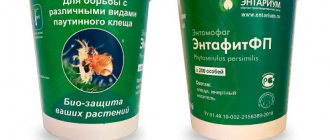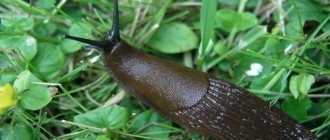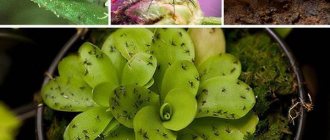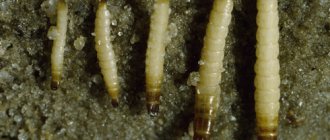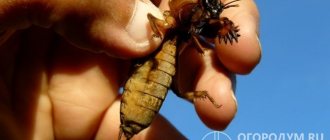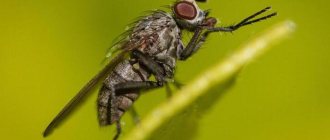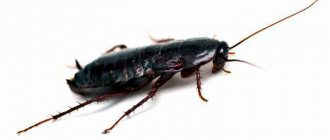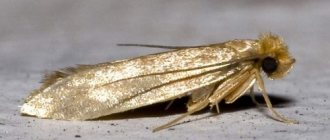What does the pest look like on cucumbers, signs of damage
Aphids are black, green or yellow very, very small bugs. The size of aphids is 1-2 (and sometimes even smaller) millimeters.
In just a few days, aphids can infest all the cucumber beds in the garden. Colonies most often live on the underside of leaf blades and shoots of cucumbers. The pest makes punctures through which it drinks juice and takes away nutrients. The parasite instantly sticks to the entire cucumber bush and depletes it, so the cucumbers die.
Important! In open ground, aphids usually appear after June 20, and in a greenhouse they live from the beginning of spring.
What happens to cucumbers when aphids appear:
- the tops of the stems are deformed;
- the edges of the leaves curl downwards;
- cucumber growth stops;
- shortening of internodes (areas between the stem and shoot) occurs;
- new fruits are not formed;
- the leaves are covered with honeydew - a sticky sweet liquid;
- the ovaries fall off and the leaf plates located below wither;
- ants appear next to the cucumber bush;
- You can see the larvae on the underside of the leaves.
Features of the fight against aphids in closed and open ground
To get rid of aphids in the greenhouse and in the garden, the same chemical, biological, folk remedies and agrotechnical methods are used. When working with chemicals, use respirators to protect the respiratory tract and long sleeves to protect the skin. Neglecting this rule risks serious poisoning of the body.
To increase immunity, plants are fed with potassium-phosphorus fertilizer (10 g of potassium sulfate, 20 g of superphosphate/10 l of water). Plantings are sprayed with the solution 1 time/10 days. Aphids are less likely to attack strong and healthy bushes.
In the fall, 10-15 cm of the top layer of soil in the greenhouse is removed or treated with copper-containing preparations and sulfur bombs.
They dig up the soil in an open area, weed out weeds, uproot old stumps, and get rid of anthills in which aphids overwinter.
Reference. Anthills are filled with Anteater or hot water, and the beds are regularly loosened to repel insects.
Why are aphids dangerous for cucumbers?
Aphids are insect pests that reproduce at an incredible rate. Affects all plants except pine needles. Most often found on climbing plants. There are more than 4,000 species of these insects in the world.
Cucumbers are also often affected by black aphids. If you do not take immediate action after detecting a pest, you may be left without a harvest.
How do aphids get into the area?
Larvae and wingless females overwinter in weeds and on basal foliage. With the onset of warm weather, the pest becomes more active, flying over existing plants on the site and reaching vegetable crops.
A parasitic insect acts as a carrier of pathogens of viral, bacterial and fungal diseases that affect cucumbers.
The migration begins at the time of planting of seedlings.
Aphids can settle on cucumbers planted both in open ground and in a greenhouse.
- Peak activity in the first case: end of June – July.
- Favorable conditions in greenhouses arise by mid-spring.
Favorable factors that contribute to the active reproduction of the pest are high humidity and high ambient temperature. Each female can produce up to 10,000 individuals in a month.
Symptoms of aphids
Cucumbers are mainly attacked by the melon aphid, or as it is also called the cotton aphid. Favorite crops of this species are pumpkin, watermelon, melon, cabbage and legumes. The insect reaches 2 mm in length, the body is colored yellow or green. You can detect the pest by turning the cucumber leaf over with its back side. On the surface it is easy to notice a cluster of aphids sucking juice from the tissues of young shoots.
Literally 2-3 days after the attack, the pest can be identified by the foliage curled inward and the stems covered with insects. Flowers and ovaries fall off, shoot growth stops.
The spread of aphids is largely facilitated by ants. They feed on the sticky secretions of the insect and transfer the colony to the cucumber beds. Therefore, another indirect sign that the crop has been attacked are ant paths around the bushes and on the stems.
Aphids reproduce at lightning speed and can destroy cucumbers in a few days. You can quickly defeat a large colony using chemicals. The disadvantage of most toxic insecticides is that as a result of their use, substances harmful to humans accumulate in cucumbers.
Vegetables can be collected only 3 weeks after spraying. Biological products are more suitable for processing cucumbers, the composition of which allows harvesting in a few days.
Folk remedies are safe, but do not work immediately and are effective at the initial stage of the fight, when aphids have not had time to take over a large area of planting.
That is why experienced gardeners are doing their best to prevent the invasion of the pest, instead of fighting it. If aphids have already appeared on cucumbers, you should determine the extent of the damage and choose an adequate method of control.
What are aphids and how are they dangerous for plants, including cucumbers?
There are a huge number of varieties of aphids. melon aphids on all pumpkin crops, including cucumbers . cabbage and legumes ( beans , peas also suffer from its invasion . Although a pest such as aphids is small in size (body length no more than 2 mm), it is very prolific and reproduces in a matter of days , instantly occupying all garden beds.
The harm that the melon aphid causes to cucumbers is that it pierces the leaves and young shoots, thereby sucking out the juice of the plant . Shoots slow down, fruit formation decreases significantly, plants wither and die.
Aphids are also dangerous because they can carry dangerous viral diseases , which can lead to even more widespread damage.
The difficulty in detecting aphids is that they settle on the back of the lower part of the leaves , which is why they are not very easy to notice.
Most often, the first sign of aphids on cucumbers is curling of the edges of the leaves towards the bottom , as well as bending and deformation of the tops of the shoots. Accordingly, the growth of the entire plant slows down and gradually stops, internodes become shortened, and fruit formation decreases significantly. If measures are not taken to combat aphids, the plant will wither and eventually die.
Causes of aphids
The first reason for the appearance of aphids on cucumbers is ants. They feed on sweet dew, which is formed as a result of the activity of pests and accumulates on the back of the leaves. Moving from place to place, the ants carry the larvae on themselves, spreading aphids throughout the area.
The second reason is violation of agrotechnical rules. Untimely weeding, dense planting of cucumbers, poor ventilation in the greenhouse, increased nitrogen content in the soil - all this contributes to the appearance of aphids on the site.
The bugs find shelter in dried weeds and plant remains from last season. Females intensify their activity in the spring, when the air warms up to +5°C. The ants carry the insects to young plants, where the females begin to lay eggs on the back of the leaves.
Only female individuals are born from the progenitor, who have the opportunity to move to other plantings. To reproduce 20 generations of the pest, it will take only no more than 10 days.
If your cucumbers grow in a greenhouse or greenhouse, then they can become prey for another type of aphid - the potato aphid. In addition, there is also a black aphid; it can settle on any plant, be it a weed or a vegetable.
It doesn’t matter which type of pest lives on your cucumbers, any of them can destroy all plantings in a short time. Therefore, it is so important to process plants in a timely manner so as not to lose the harvest.
Signs of appearance
Aphid colonies on cucumber leaves can be seen with the naked eye. Most often they are concentrated on the young growth of the plant on the lower part of the foliage, since these areas are the most succulent. It is important to regularly inspect the plantings to monitor their appearance in order to notice the pest in time and eliminate it. The presence of aphids can be determined by the following common symptoms:
- Yellowing and curling of leaves. Oppressed by the attacks of the parasite, the plate loses turgor and begins to gradually fade.
- Changing the shape of new young shoots. Deformation in the form of severe curvature occurs as insects exhaust the bulk of the nutritional juice from the growth.
- Drying and delayed fruit development. Aphids usually infect a plant during the growing season, but it can also linger on crops that are already bearing fruit. If it develops massively during growth, the bushes may die before the fruits form.
- The appearance of a sticky white coating with a characteristic shine on the surface of the petals of the inflorescences. This is sweet honeydew - a product of the vital activity of aphids, on which a microscopic fungus settles and develops. Over time, young shoots acquire a black tint due to the activity of these microorganisms.
An important sign of aphid infestation is an increase in the number of ants in the area and their active movement along the stems of the plant.
Photo
Photo
Photo
What types of aphids attack cucumbers?
Cucumber plantings, as we noted above, most often become the habitat of melon aphids. It adapts very quickly to the bushes and begins to multiply rapidly.
It happened that, leaving the site for several days, gardeners returned to dead bushes that were covered with aphids. It feeds on juice, sucking out all the useful substances, without which cucumbers stop growing and die.
Description of the pest
Aphids on plants can be noticed when a whole colony has already appeared, and single specimens are too small for our eyes. Melon aphids (also called cotton or cucumber aphids) are very small insects, less than 2 mm. They come in different colors: from yellowish-green to dark green, and sometimes even black. Larvae and females overwinter on the basal leaves of perennial weeds. As the air temperature rises, they become more active and at +5 degrees they begin to multiply very quickly.
It must be said that at first all these insects do not have wings, but at some point, when overpopulation threatens a lack of food, winged individuals begin to be born. They fly to other plants in search of food. By this time, the cucumbers, as a rule, have already grown real leaves, and they become a new haven for aphids.
Aphids feed on plant sap, but at the same time secrete a toxic substance. In addition, it infects cucumbers with various diseases, since it carries a huge number of viruses. On the underside of the leaves, hiding from the sun, it forms huge colonies, then spreads over all the stems and flowers, sucking the juice out of them.
The fight should begin as early as possible, otherwise the aphid will destroy the plant and move on to the next one. This way, you may not wait for fruiting and infect other crops with aphids.
How to fight aphids on cucumber leaves: various methods and prevention
There are many biological and chemical means, as well as folk methods for controlling aphids on cucumbers in open and closed ground.
Important! When fighting aphids, you must immediately fight the ants that live next to the beds.
Ants bring wingless female aphids to plants, and winged ones migrate on their own. In addition, ants love the sticky juice secreted by aphids. Therefore, ants protect aphids from predatory insects; in winter they hide them in an anthill, and in the spring they transfer them to planted seedlings. Therefore, you need to fight aphids and ants with the same chemicals, for example, Inta-vir. Or water and sprinkle the soil around the anthill with garlic, cinnamon and other products that emit a pungent odor.
Prevention measures:
- do not thicken plantings;
- remove weeds regularly;
- fertilize the crop on time.
To prevent aphids from appearing on cucumbers in a greenhouse, the greenhouse and hotbed must be treated in spring and autumn with special means. The main thing is to detect aphids in time, otherwise they will destroy the entire crop.
They try to fight aphids on cucumbers with folk and biological preparations, since the use of any chemicals is undesirable at the time of fruiting.
Prevention
When cucumbers are infested with aphids, it is necessary to take insect control measures. But to avoid problems, carry out preventive measures in a timely manner.
In the greenhouse
You can prevent the appearance of aphids by regularly treating the soil and the structure itself. Carrying out the following procedures will reduce the chances of aphids taking over a greenhouse cucumber plantation:
- Disinfection of the greenhouse. The structure should be disinfected with special means every autumn. Use copper sulfate, Bordeaux mixture, and bleach as an antiseptic. Before the procedure, dispose of all plant debris from the greenhouse, as they may contain pest larvae.
- Promptly getting rid of ants. This family of insects often lives in greenhouses, since there are suitable conditions for their normal life. They raise aphids for their juice and allow them to overwinter in anthills. Destroying aphids without first exterminating the ants is pointless. To do this, use special means and folk methods. In addition, treat not only the greenhouse, but also nearby areas.
- Preventive treatments. Even in the absence of visible symptoms, periodically treat the plant with biological agents against aphids for preventive purposes. Most often, gardeners use Fitoverm because of its environmental safety.
- Agrotechnical methods. Regularly introduce fertilizing and monitor the growing conditions of crops to strengthen their immune resistance. A strong and healthy plant will be able to resist pests.
- Attracting predatory insects. Ladybugs feed on aphids and can help reduce aphid numbers in a greenhouse without harming the crop. To do this, carefully collect these insects from the garden and send them to the greenhouse. Over time, they will take root and begin to lay larvae, which are also not averse to feasting on aphids.
To minimize the risk of pest damage to cucumbers, you need to choose varieties that are resistant to this pest.
Thanks to breeding work, many cucumber seeds have been obtained that resist aphids. When purchasing, this positive side of the culture is indicated on the product packaging.
In the open ground
To prevent the infestation and spread of aphids on cucumbers in open beds, it is necessary to perform certain actions:
- Properly prepare the place for planting vegetables. Mow the weeds in the fall, clear the area of fallen leaves, cut out the tops and root shoots on which the larvae can overwinter.
- During spring and summer, destroy anthills located in close proximity to cucumber beds.
- Weed and thin out. Weeds are an intermediate habitat for dangerous pests. To prevent its occurrence on cucumbers, you should carefully weed the soil between the bushes. Aphids also prefer dense plantings so that they can move easily. Keeping your distance in the event of an attack can slow down the spread of insects.
- Plant bait plants. Aphids prefer young, succulent crops. Therefore, next to the cucumbers it is better to plant bait with more delicate leaves, for example, dill and beans. After identifying insects on them, burn them along with the pests.
- Attract biological enemies. Aphids are part of the food chain, so there are predatory insects that eat them. By increasing the population of such organisms, it is possible to reduce the number of pests without harming plants. Enemies of aphids include ladybugs, lacewings, wasps, and birds. To attract them, plant carrots, parsley, dill and other fragrant herbs next to the cucumbers. Kinglets, sparrows, and tits feed aphids to their chicks. To attract them, you need to build birdhouses and place drinking bowls with water.
- Plant repellent crops near cucumber plantings. Aphids cannot stand the smell of cilantro, mustard, mint, and basil. Sow them along the edges of the cucumber beds.
- Treat bushes with biological and folk remedies. If there are no signs of a pest, it is necessary to carry out sanitary treatment with environmentally friendly and safe preparations.
Aphids are sensitive insects and the presence of unsuitable conditions for their life can be a decisive factor. Therefore, so that you don’t have to use chemicals to control pests later and endanger the quality of the fruit and your health, it is better to initially scare off the parasites from the cucumber bed.
How to treat aphids - effective preparations
The industry has developed many effective insecticides to combat aphids.
The group of biological products that can get rid of aphids includes:
- "Fitoverm" instantly destroys aphids; it is possible to treat a large area with it.
- “Aktofit” is the same active ingredient as in “Fitoverm.” The drug inhibits the nervous system of aphids and effectively kills the parasite within a few hours.
- "Akarin" is another effective biological insecticide. It is necessary to repeat spraying at intervals of one week until the aphids are completely exterminated.
- "Biotlin" - the main advantage of the drug is that it provides effective protection for three weeks. This is possible due to the special principle of action of the drug: the substance enters the bush, and then penetrates into all affected parts of the cucumber bush. After eating the leaves and shoots of cucumbers, aphids and their larvae die from poison.
- “Bitoxibacillin” - many gardeners recommend this effective drug for controlling aphids. One of the main advantages of Bitoxibacillin is safety for humans, animals and all insects, in addition to aphids.
- “Healthy Garden” is the safest of biological products. It is used during the fruiting period of cucumbers, since five days after spraying the cucumbers can be collected and eaten. The dosage for combating aphids is 2 granules per 500 ml of water. The effect of treatment on cucumbers lasts up to 20 days.
The best chemical-based aphid control products:
- "Inta-vir"
- "Karbofos"
- "Iskra-bio"
- "Spark-golden"
- "Iskra-M"
- "Commander"
- "Aktellik"
- "Fufanon"
- "Alatar"
- "Aktara"
All these drugs to combat aphids penetrate the tissues of cucumbers so that the insect, along with the cell sap, receives a dose of a toxic substance.
Damage to melon aphids for planting cucumbers
This small “harmful” bug is very voracious and can attack not only melons, but also cotton, and if the fight against it is not started in a timely manner, then the aphid can destroy plantings over a large area.
On cucumber vines, an aphid colony first appears on the lower leaf blades, but gradually the pest begins to move to the juicier upper leaves.
Important!
From the leaf plates, the aphid sucks out cell sap, which is rich in carbohydrates and amino acids; as a result, the foliage begins to turn yellow and shrink, and then dies earlier than expected.
As a result, cucumber vines reduce the rate of their development and very often die. In the remaining vegetable crops, the eaten ovaries and buds fall off, as a result, the yield of cucumber bushes decreases.
This “harmful” bug is also a carrier of a number of pathogenic microorganisms, so cucumber vines, weakened by aphid attacks, can be affected by these associated diseases.
Useful article:
Mosaic virus on plants - how to identify the disease and control methods
Therefore, disease control measures should be included in the aphid control complex.
The female of this pest is not only gluttonous, but also very fertile and can lay at least 100 eggs every 12-14 days. As a result, up to 20,000 new pests may appear per season.
Such a number of aphids can destroy all garden plants in a short period of time, so the fight against them must be merciless.
Melon aphid on cucumbers: what to do? - video
What are the dangers of chemical treatment?
Chemicals are used to control aphids only in emergency cases, when other control methods have not brought the desired effect.
Aggressive insecticides effectively help get rid of parasitic insects, but they are not used during flowering and fruiting of cucumbers. Toxic substances accumulate in tissues and can harm people, pollinating insects and spoil vegetables.
Viruses and bacteria can cause spots on cucumbers
How to fight
The same drugs work against cucumber bacteriosis as against fungi. Especially those containing copper. There are no antiviral drugs yet. You can support the immunity and vitality of plants with the help of stimulants: Epin, Ecoberin, Extrasol, etc. Regular spraying with skim milk inhibits the spread of the disease.
How to prevent
In this case, early protection of the garden is more relevant than ever. The good news is that “defensive measures” are familiar to us. Nothing supernatural!
- Choose resistant varieties and hybrids of cucumbers. We gave descriptions of some resistant varieties HERE.
- Prepare seeds for sowing. Soaking seeds for 12 hours in a solution of complex fertilizer with microelements works great;
- Maintain crop rotation. And again we remind you of the need to change the location of the cucumber bed every year. Preferably taking into account good and bad predecessors.
- Do not leave tops in the garden. And compost it! Viruses will burn out in compost, but can safely survive in the garden;
- Disinfect equipment and greenhouse. For example, spray the walls with a bright solution of potassium permanganate.
- Control aphids, the main carrier of the mosaic virus. We talked about how to defeat aphids without “chemistry” HERE.
Folk remedies
Many gardeners avoid using any chemicals in their vegetable beds. Then time-tested home recipes for fighting aphids on cucumbers come to the rescue. The safety and availability of such methods compensate for the slower effect and the need for repeated treatments.
Wood ash
An infusion using ash helps fight many pests and strengthens the immunity of cucumbers. To ensure that the powder diluted in water is firmly attached to the shoots, shavings of laundry or tar soap are added to it. The resulting liquid becomes sticky and lingers longer on the surface of the leaves.
Take 200 g of sifted ash and 40 g of shavings per bucket of water. Stir in warm water and let sit for at least 12 hours. Spray cucumbers against aphids in the morning, paying special attention to the back of the leaves.
Pine needle extract
The needles have a pronounced aroma that aphids cannot stand. For a long time, this product has been widely used by gardeners to repel insects. In addition, needles have a number of useful properties:
- Strengthens the immunity of plantings. Bushes damaged by aphids begin to hurt; pine extract supports the plants and reduces the risk of their death.
- Thanks to essential oils, the product perfectly fights against a large number of bacteria and infections, preventing the development of diseases.
The extract is sold in almost any pharmacy. To prepare the solution 1 tbsp. l of the substance is diluted in a bucket of water (10 l). To keep the composition on the leaves longer, you can add 2 tbsp. l pre-grated laundry soap.
The resulting solution is used for spraying. After treatment, the greenhouse or greenhouse should be closed and left for 2-3 hours. The main advantage of the product is that after its use, essential oils retain their scent for a long time. This fact helps to avoid the recurrence of pests.
Soda
Soda is recommended by many gardeners who have struggled with aphids in their area. Also, soda is effective in the fight against fungal, bacterial and viral diseases and helps increase the yield of cucumbers.
The recipe for an effective remedy is quite simple: for 1 liter of water you will need 2 teaspoons of soda and a little grated laundry soap. Mix thoroughly and sprinkle cucumber bushes with this solution.
Ammonia
The pungent smell of ammonia effectively repels pests from cucumber beds. Ammonia (10%) is diluted in water in a ratio of 50 ml per 10 liters. To achieve maximum results, add soap solution and 3 tbsp. l vegetable oil. Plants are sprayed for both medicinal and preventive purposes.
It is advisable to carry out the treatment in the first half of the season, due to the fact that ammonia enriches the plants with nitrogen. During the fruiting period, this can cause unwanted growth of green mass to the detriment of setting cucumbers.
Vinegar
To treat cucumbers against aphids, prepare the following solution:
- 1 tbsp. spoon of acetic acid;
- 1 liter of water;
- 1 tbsp. spoon of laundry soap or detergent.
In further recipes you need to add soap, but you can discard the oil.
Milk with iodine
Spraying cucumbers with a milk solution with iodine gets rid of aphids due to the film that forms and its antiseptic properties. Per liter of water use 1 ml of the drug, 100 ml of milk (can be replaced with whey). The liquid is shaken and poured into a spray bottle.
Spraying is carried out over the entire surface of the shoots in cloudy weather. It is not recommended to use homemade milk, since excess fat on the surface of cucumber leaves interferes with normal air exchange.
Mustard powder
Mustard powder is good for controlling aphids. The solution is prepared as follows:
- 100 g powder;
- 3 liters of boiling water;
- Leave for 5-6 hours (stirring occasionally);
- after the mustard settles, the liquid is poured into a 10-liter sprayer
- add 5 tbsp. spoons of liquid laundry soap;
- 3 tbsp. spoons of sunflower oil;
- 7 liters of water.
- Spraying is carried out.
Infusion of tomato tops
Tomato tops are an effective means of fighting beetles due to the fact that they contain the poison solanine.
Healthy tomato greens are useful for making a healthy infusion. You need to take 1 kg of tops. The mixture is kept for about five hours, then a little soap is added. After flowering ends, spray the cucumbers with the solution. Number of treatments – up to four times per summer.
How to use onion peel infusion
The parasite absolutely cannot stand the smell of onions and leaves the garden. In addition, onion infusion helps get rid of pathogenic flora in the soil and enriches the soil with useful substances.
You can get rid of the pest by mixing 0.2 kg of onion scales and a bucket of water. The container is closed and put in a dark place for five days. Next, the solution is filtered and the aphids are destroyed.
Sagebrush
Take 8-10 fresh wormwood bushes along with roots, chop and dry. Then put it in a 10-liter bucket, pour boiling water over it and leave it overnight to let it sit. Already in the morning the product can be used to spray cucumbers. This is excellent protection against aphids and other pests.
Fifteen home methods to combat aphids
Important! To completely get rid of aphids, it is necessary to treat cucumbers every four days, repeat the procedure at least three times, and it is advisable to use various means for them to work. It is necessary to process the undersides of the leaves, preferably after the end of daylight, if in a greenhouse, then before it begins.
1. Using mustard powder To combat aphids, use mustard powder, dilute one hundred grams in three liters of hot water and leave for six hours. Then you need to strain the solution and add five tablespoons of soap, three tablespoons of oil to the liquid and dilute with seven liters of water. Next, you can spray the plant with a spray bottle.
2. Using baking soda The baking soda solution is also simple to prepare: dilute fifty grams of baking soda in ten liters of water, plus laundry soap and oil in a ratio of five to three tablespoons.
3. Using ammonia Ammonia is an effective remedy for aphids on cucumbers. An obligatory component of this solution will also be soap and oil (the quantities are higher), in addition to this, dilute fifty milliliters of alcohol in ten liters of water.
4. Using table vinegar It is believed that vinegar solution is very effective. You will need a tablespoon of vinegar and a tablespoon of grated natural soap, mix the ingredients and dilute in a liter of water.
5. Using wood ash, dilute two hundred grams of ash (wood) in ten liters of water, and let the decoction steep for twelve hours. The ash must be pure wood - not painted, varnished, or glued.
6. Using soap
The simplest solution: dilute one hundred grams of grated natural soap in ten liters of water.
7. Using garlic The next infusion is garlic. Grind one hundred and fifty grams of garlic and leave in ten liters of boiling water for twenty-four hours, strain and can be used.
8. Using onion peels Onions are effective, for ten liters of boiling water you need two hundred grams of onion peels, the infusion should be infused for five days and filtered.
9. Using pine needles In ten liters of water you need to dissolve one tablespoon of pine infusion. Then spray on the plants.
10. Using tobacco Four hundred grams of crushed tobacco are added to ten liters of water, the infusion should stand for twenty-four hours. After tincture, strain the infusion and mix with three tablespoons of soap. Tobacco dust works quite well against a large number of pests.
11. Using vegetable tops, fill a three-liter jar with fifty percent tops (tomatoes/potatoes), then add hot water to the brim of the jar, let the infusion sit for a day.
12. Using chamomile Infusion of chamomile - pour ten liters of hot water into a kilogram of chamomile flowers, leave for twelve hours. Then you need to add twice as much water and forty grams of soap per ten liters of infusion.
13. Using sorrel
Three hundred grams of dried sorrel roots are placed in ten liters of hot water, this solution is infused quickly - just a couple of hours.
14. With the help of insects In addition to home methods, predatory insects can also help, oddly enough. You can use ladybugs.
15. Using soap Infusions and decoctions are often used to fight insects; three tablespoons of soap will need to be added to all of them. The use of biological preparations against aphids When you did not have time to carry out prevention or it did not help and the aphids have already multiplied, you can use so-called fungicides; they are biological preparations. On average, biological agents take effect within six days, after which the fruits can be eaten.
Aphids on cucumber seedlings
Cucumber seedlings themselves are still weak enough to undergo serious processing. If you notice the appearance of aphids on young plantings that have recently been planted in the ground, it is strictly not recommended to treat them with aggressive chemicals. The bush may not survive this.
In addition, most folk natural remedies are designed for an adult adapted plant. They can also be destructive for seedlings.
To combat the pest in the first stages of cucumber development, you can only use a herbal solution of chamomile or celandine, manually treating all affected areas.
What insects will help get rid of aphids?
The main enemies of these pests are ladybugs and their larvae - black with red or orange dots on their sides. Within a day, one such individual can destroy up to 50 pieces. aphids.
Predatory gall midges are another assistant to the vegetable grower in the fight against aphid invasion. They settle on herbs and legumes, so these crops can be grown next to cucumber beds for breeding gall midges. Lacewings also destroy aphids.
Chemicals against aphids
If biological agents also do not give positive results, you can resort to chemical agents. They act instantly and are used in cases of extensive aphid infestation, when there is a risk of losing the entire crop. Here are the most effective of them:
- "Alatar" is an effective remedy for pest control. Contains two active components that mutually enhance the effect of the drug. For a long time, after spraying, it is not washed off from the treated surface. Economical consumption. The dosage must be strictly followed according to the instructions.
- Actellik is better than other insecticides in that it kills pests without being absorbed by plant leaves. Can be used for vegetable gardens, greenhouses, orchards, forests. It also protects indoor plants.
- "Inta-Vir" is an effective product that can destroy more than 500 pests. Suitable for greenhouses, open ground. Consists of components of plant origin: chamomile, chrysanthemum, tansy juice. Shows good results against aphids and caterpillars.
- “Fufanon” - 10 ml diluted with 10 liters of water. And after application, the harvest can be harvested only after 20 days.
- “Fufanon-nova” - 2 ml diluted in 1.5 liters of water. After 2 days you can already pick cucumbers.
- "Karbofos" - 2 tbsp. spoons should be diluted in 10 liters of warm water, sprayed inside the greenhouse, roofing, paths, soil and a little on the plants. It is advisable to carry out the procedure when the sun is shining. All doors and windows must be closed. You can spray with a product prepared from 1 tbsp. spoons of karbofos diluted in 10 liters of water. The leaves below need to be processed more carefully. After 1 hour, the beds need to be loosened by 1-2 cm.
- “Commander” - dilute 3 ml per 6 liters of water. 3 days after spraying, you can harvest.
Important! Most of the drugs can be used a month before harvesting the fruits. It is better to use them in spring or early summer.
What aphid attacks cucumbers?
The body of the melon or cotton aphid (Aphis gossypii) has the shape of an elongated oval, no more than 2 mm long, the color can be any shade of green, black or yellow. The insect can be compared in visual characteristics to a grain of colored rice.
The tiny insect actively reproduces; during a season, one individual can produce several generations, each of which gathers in a colony. The aphid has a “patron” who is also its distributor – the ant.
Plants can be saved only at the initial stage of infection. The fight is also complicated by the fact that it is impossible to use effective products based on chemical components during the flowering and fruiting period of cucumbers. Most drugs are absorbed by the fruits, the crop becomes unsuitable for consumption.
Related article:
Fighting currant bud mite
Description and life cycle of the pest
The small dirty insect melon aphid with particular zeal primarily colonizes the plantings of cucumbers and zucchini. In open ground it appears from the end of June, in greenhouses and greenhouses - much earlier, approximately 2-4 weeks after planting the seedlings.
Wingless females and aphid larvae spend the winter hiding under the rosette leaves of perennial weeds. Sometimes ants provide reliable shelter by hiding their nurses in holes. As soon as warm weather sets in (+10–12 °C), the aphids immediately leave their wintering place and colonize the nearest plant, sucking the life juices out of it. When there is a lack of food, the insects develop wings, allowing them to move in search of a suitable “victim”. Unfortunately for gardeners, this process coincides in time with the timing of planting cucumber seedlings. If the pest chooses young plants for its “dining room”, the seedlings will not withstand the pressure and will die.
The pest reproduces depressingly quickly: each female reproduces 40 of its own kind at a time. Aphids are viviparous insects; the larvae reach the adult stage in just 10 days. That is, about 20 generations are born per season, which pose a threat not only to melon crops. Beans, beets, and berries are under threat. All individuals are parthenogenetic females, i.e. reproduction occurs through self-fertilization.
Aphids are a cosmopolitan pest, that is, they live in all regions.
Symptoms of infection
Most often, the provocateur of the appearance and reproduction of these pests on the site is the gardener himself, thickening the beds or greenhouses, not removing weeds in a timely manner, ignoring the appearance of a large number of ants.
You can recognize a pest attack on cucumbers by the following signs:
- the growth and development of the plant stops, internodes are shortened;
- the activity of flowering and fruiting decreases, the ovaries fall off;
- cucumber leaves begin to curl, the lower ones wither;
- sticky drops (honey dew) appear on the foliage and stems - a waste product of insects;
- the tops of the main stem and lateral branches are deformed;
- Ants appear around the cucumber plot.
If you notice one or more of the listed symptoms, you should immediately examine the cucumbers. Aphids are located on the underside of leaves, sometimes crawl onto trunks, and make their way into buds. Rarely occurs on fruits. The choice of spraying agent for the plant depends on the intensity of the infection.
Related article:
How I managed to get rid of wireworms in the garden: personal experience
Even if it is impossible to save the plantings, treatment will have to be carried out. Affected plants are removed from the site, burned outside, and the soil is sprayed with insecticides.
